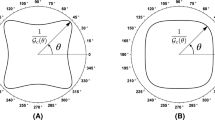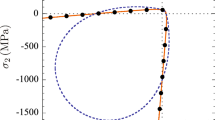Abstract
Phase field theory is developed for solids undergoing potentially large deformation and fracture. The elastic potential depends on a finite measure of elastic strain. Surface energy associated with fracture can be anisotropic, enabling description of preferred cleavage planes in single crystals, or isotropic, applicable to amorphous solids such as glass. Incremental solution of the Euler–Lagrange equations corresponds to local minimization of an energy functional for the solid, enabling prediction of equilibrium crack morphologies. Predictions are in close agreement with analytical solutions for pure mode I or pure mode II loading, including the driving force for a crack to extend from a pre-existing plane onto a misoriented cleavage plane. In an isotropic matrix, the tendency for a crack to penetrate or deflect around an inclusion is shown to depend moderately on the ratio of elastic stiffness in matrix and inclusion and strongly on their ratio of surface energy. Cracks are attracted to (shielded by) inclusions softer (stiffer) than the surrounding matrix. The theory and results apparently report the first fully three-dimensional implementation of phase field theory of fracture accounting for simultaneous geometric nonlinearity, nonlinear elasticity, and surface energy anisotropy.







Similar content being viewed by others
References
Abdollahi A, Arias I (2012) Numerical simulation of intergranular and transgranular crack propagation in ferroelectric polycrystals. Int J Fract 174:3–15
Alber HD (2012) A model for brittle fracture based on the hybrid phase field model. Contin Mech Thermodyn 24:391–402
Amor H, Marigo JJ, Maurini C (2009) Regularized formulation of the variational brittle fracture with unilateral contact: numerical experiments. J Mech Phys Solids 57:1209–1229
Arias I, Knap J, Chalivendra V, Hong S, Ortiz M, Rosakis A (2007) Numerical modelling and experimental validation of dynamic fracture events along weak planes. Comput Methods Appl Mech Eng 196:3833–3840
Atkinson C (1972) The interaction between a crack and an inclusion. Int J Eng Sci 10:127–136
Borden M, Verhoosel C, Scott M, Hughes T, Landis C (2012) A phase-field description of dynamic brittle fracture. Comput Methods Appl Mech Eng 217:77–95
Clayton J (2005) Dynamic plasticity and fracture in high density polycrystals: constitutive modeling and numerical simulation. J Mech Phys Solids 53:261–301
Clayton J (2006) Continuum multiscale modeling of finite deformation plasticity and anisotropic damage in polycrystals. Theoret Appl Fract Mech 45:163–185
Clayton J (2008) A model for deformation and fragmentation in crushable brittle solids. Int J Impact Eng 35:269–289
Clayton J (2009) A continuum description of nonlinear elasticity, slip and twinning, with application to sapphire. Proc R Soc Lond A 465:307–334
Clayton J (2010) Deformation, fracture, and fragmentation in brittle geologic solids. Int J Fract 163:151–172
Clayton J (2010) Modeling nonlinear electromechanical behavior of shocked silicon carbide. J Appl Phys 107:013,520
Clayton J (2011) Nonlinear Mechanics of Crystals. Springer, Dordrecht
Clayton J (2014) Finite strain analysis of shock compression of brittle solids applied to titanium diboride. Int J Impact Eng 73:56–65
Clayton J, Knap J (2011) A phase field model of deformation twinning: nonlinear theory and numerical simulation. Physica D 240:841–858
Clayton J, Knap J (2011) Phase field modeling of twinning in indentation of transparent crystals. Model Simul Mater Sci Eng 19:085,005
Clayton J, Knap J (2013) Phase-field analysis of fracture-induced twinning in single crystals. Acta Mater 61:5341–5353
Clayton J, McDowell D (2003) Finite polycrystalline elastoplasticity and damage: multiscale kinematics. Int J Solids Struct 40:5669–5688
Clayton J, McDowell D (2004) Homogenized finite elastoplasticity and damage: theory and computations. Mech Mater 36:799–824
Del Piero G, Lancioni G, March R (2007) A variational model for fracture mechanics: numerical experiments. J Mech Phys Solids 55:2513–2537
Eastgate L, Sethna J, Rauscher M, Cretegny T (2002) Fracture in mode I using a conserved phase-field model. Phys Rev E 65:036,117
Erdogan F, Gupta G, Ratwani M (1974) Interaction between a circular inclusion and an arbitrarily oriented crack. J Appl Mech 41:1007–1013
Espinosa H, Zavattieri P (2003) A grain level model for the study of failure initiation and evolution in polycrystalline brittle materials. Part I: theory and numerical implementation. Mech Mater 35:333–364
Evans A (1974) The role of inclusions in the fracture of ceramic materials. J Mater Sci 9:1145–1152
Faber K, Evans A (1983) Intergranular crack-deflection toughening in silicon carbide. J Am Ceram Soc 66:C94–C96
Foulk J, Vogler T (2010) A grain-scale study of spall in brittle materials. Int J Fract 163:225–242
Gell M, Smith E (1967) The propagation of cracks through grain boundaries in polycrystalline 3% silicon–iron. Acta Metal 15:253–258
Gilman J (1960) Direct measurements of the surface energies of crystals. J Appl Phys 31:2208–2218
Gilman J (2003) Electronic basis of the strength of materials. Cambridge University Press, Cambridge
Hakim V, Karma A (2009) Laws of crack motion and phase-field models of fracture. J Mech Phys Solids 57:342–368
He MY, Hutchinson J (1989) Crack deflection at an interface between dissimilar elastic materials. Int J Solids Struct 25:1053–1067
Hofacker M, Miehe C (2012) Continuum phase field modeling of dynamic fracture: variational principles and staggered FE implementation. Int J Fract 178:113–129
Jin Y, Wang Y, Khachaturyan A (2001) Three-dimensional phase field microelasticity theory and modeling of multiple cracks and voids. Appl Phys Lett 79:3071–3073
Kim BY, Wakayama S, Kawahara M (1996) Characterization of 2-dimensional crack propagation behavior by simulation and analysis. Int J Fract 75:247–259
Knap J, Ortiz M (2003) Effect of indenter-radius size on Au(001) nanoindentation. Phys Rev Lett 90:226,102
Knap J, Sieradzki K (1999) Crack tip dislocation nucleation in FCC solids. Phys Rev Lett 82:1700–1703
Kuhn C, Muller R (2010) A continuum phase field model for fracture. Eng Fract Mech 77:3625–3634
Lawn B (1968) Hertzian fracture in single crystals with the diamond structure. J Appl Phys 39:4828–4836
Lawn B, Padture N, Cai H, Guiberteau F (1994) Making ceramics “ductile”. Science 263:1114–1116
Miehe C, Welschinger F, Hofacker M (2010) Thermodynamically consistent phase-field model of fracture: variational principles and multi-field FE implementations. Int J Numer Methods Eng 83:1273–1311
Moes N, Dolbow J, Belytschko T (1999) A finite element method for crack growth without remeshing. Int J Numer Methods Eng 46:131–150
Murrell S (1965) The effect of triaxial stress systems on the strength of rocks at atmospheric temperatures. Geophys J R Astr Soc 10:231–281
Nuismer R (1975) An energy release rate criterion for mixed mode fracture. Int J Fract 11:245–250
Ohji T, Jeong YK, Choa YH, Niihara K (1998) Strengthening and toughening mechanisms of ceramic nanocomposites. J Am Ceram Soc 81:1453–1460
Rice J (1968) Mathematical analysis in the mechanics of fracture. In: Liebowitz H (ed) Fracture: an advanced treatise. Academic Press, New York, pp 191–311
Schultz R, Jensen M, Bradt R (1994) Single crystal cleavage of brittle materials. Int J Fract 65:291–312
Spatschek R, Brener E, Karma A (2011) Phase field modeling of crack propagation. Philos Mag 91:75–95
Sun X, Khaleel M (2004) Modeling of glass fracture damage using continuum damage mechanics-static spherical indentation. Int J Damage Mech 13:263–285
Tamate O (1968) The effect of a circular inclusion on the stresses around a line crack in a sheet under tension. Int J Fract Mech 4:257–266
Voyiadjis G, Mozaffari N (2013) Nonlocal damage model using the phase field method: theory and applications. Int J Solids Struct 50:3136–3151
Wiederhorn S (1984) Brittle fracture and toughening mechanisms in ceramics. Ann Rev Mater Sci 14:373–403
Wilshaw T (1971) The Hertzian fracture test. J Phys D Appl Phys 4:1567–1581
Xu L, Huang Y, Rosakis A (2003) Dynamic crack deflection and penetration at interfaces in homogeneous materials: experimental studies and model predictions. J Mech Phys Solids 51:461–486
Xu XP, Needleman A (1993) Void nucleation by inclusion debonding in a crystal matrix. Model Simul Mater Sci Eng 1:111–132
Zhang S, Zhu T, Belytschko T (2007) Atomistic and multiscale analyses of brittle fracture in crystal lattices. Phys Rev B 76:094,114
Author information
Authors and Affiliations
Corresponding author
Rights and permissions
About this article
Cite this article
Clayton, J.D., Knap, J. A geometrically nonlinear phase field theory of brittle fracture. Int J Fract 189, 139–148 (2014). https://doi.org/10.1007/s10704-014-9965-1
Received:
Accepted:
Published:
Issue Date:
DOI: https://doi.org/10.1007/s10704-014-9965-1




